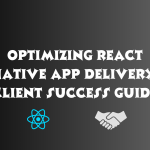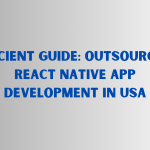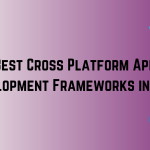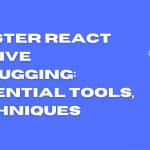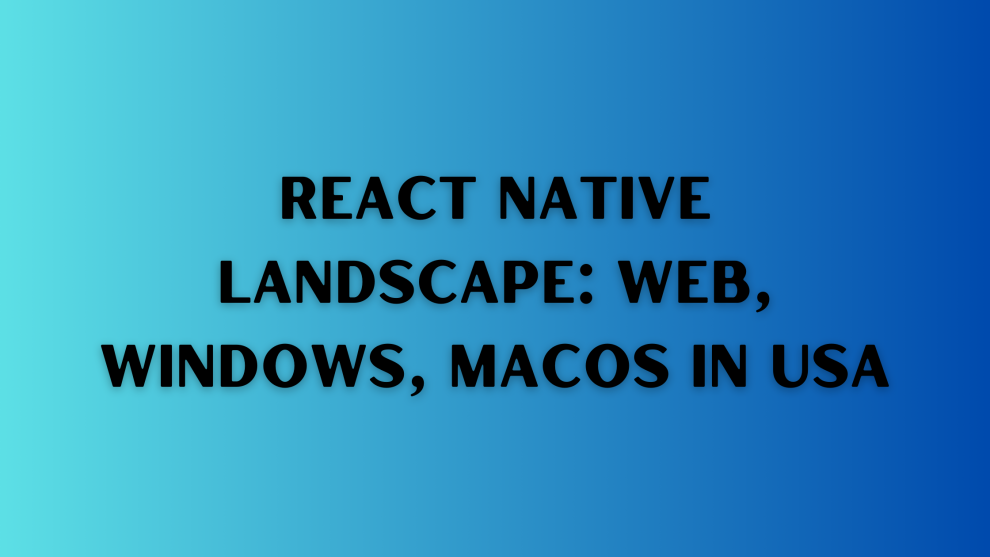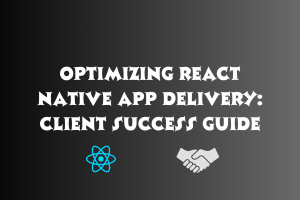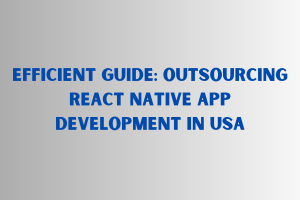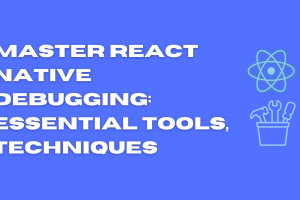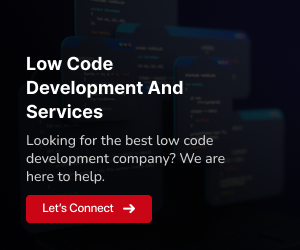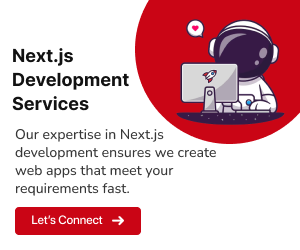In the rapidly evolving landscape of application development, React Native stands out as a beacon of innovation, prioritizing adaptability and efficiency. Initially conceptualized by Facebook for mobile applications, React Native has transcended its original purpose, extending its capabilities to include web development, as well as compatibility with Windows and macOS platforms. This blog takes a comprehensive look at the current state of React Native in the United States, shedding light on its diverse applications and impact across various platforms.
The Dynamic Evolution of React Native
React Native’s inception aimed at simplifying mobile app development, offering developers a powerful and efficient framework. As the digital landscape continued to transform, developers and businesses faced evolving demands. React Native, in line with its adaptable nature, expanded its scope to cover the vast realm of web development, serving as a bridge between mobile and web platforms.
A Trio of Platforms: Web, Windows, and macOS
This exploration goes beyond React Native’s conventional use in mobile applications. We delve into its applications in web development, where React Native for Web has become pivotal for crafting immersive and responsive user interfaces. Concurrently, React Native for Windows and React Native for macOS have taken the spotlight, providing a unified solution for developers aiming to bridge the gap between desktop and mobile ecosystems.
React Native for Web
Current Situation
React Native for Web has experienced a rapid surge in popularity, emerging as a favored option for developers aiming for a unified codebase for both mobile and web applications. With strong support from major web development frameworks like Next.js and React Router, React Native for Web has become an essential component of many development stacks.
Key Features
Cross-Platform Compatibility:
A defining feature of React Native for Web is its capability to create applications that seamlessly transition between mobile and web platforms. Developers can utilize React components to build user interfaces that feel native across a variety of devices.
Code Reusability:
An outstanding characteristic is the significant code reusability it provides. Developers can share a substantial portion of their codebase between mobile and web projects, streamlining development workflows and minimizing redundancy.
Responsive Design:
The framework facilitates the development of responsive user interfaces, enabling applications to adapt gracefully to different screen sizes and resolutions. This responsiveness ensures a consistent and enjoyable user experience across diverse devices.
Use Cases in the USA
E-commerce Platforms:
Retailers in the USA employ React Native for Web to create unified shopping experiences. By reusing code between mobile apps and web platforms, they can maintain a consistent look and feel, enhancing user engagement.
Media and Entertainment:
Media companies use React Native for Web to deliver a seamless content consumption experience. Whether users access content on a mobile device or a desktop browser, the application remains cohesive and user-friendly.
Startups and Emerging Companies:
React Native for Web has become a preferred choice for startups and emerging companies in the USA. Its efficiency in managing cross-platform development enables these businesses to bring their products to market faster and with reduced development costs.
React Native for Windows
Current Situation
React Native for Windows is gaining popularity as a robust framework for building cross-platform applications that seamlessly integrate with the Windows operating system. With continuous development efforts and a supportive community, React Native for Windows is becoming an essential tool for developers targeting the Windows platform.
Key Features
Native Windows UI Components:
One of the standout features of React Native for Windows is its capability to create applications with native Windows UI components. This ensures that the applications not only function well on Windows devices but also provide a familiar and intuitive user interface.
Integration with Windows APIs:
React Native for Windows empowers developers by offering seamless integration with Windows APIs. This capability allows developers to leverage the full spectrum of functionalities offered by the Windows operating system, enhancing the richness of their applications.
Use Cases in the USA
Corporate Applications:
Large enterprises in the USA are adopting React Native for Windows to build internal applications. These applications, designed with native Windows UI components, offer a consistent and efficient experience for employees using Windows devices.
Productivity Tools:
Developers are using React Native for Windows to create productivity tools that seamlessly align with the Windows environment. Whether it’s project management software or communication tools, React Native for Windows ensures a native user experience.
Educational Software:
In the education sector, React Native for Windows is employed to develop interactive educational software. The framework’s ability to provide a native feel on Windows devices enhances the learning experience for students using desktop applications.
React Native for macOS
Current Situation
React Native for macOS is gaining popularity as a robust framework for constructing applications specifically designed for the macOS ecosystem. By harnessing the capabilities of React Native, developers can create applications that work seamlessly across platforms while integrating with the distinctive features and design principles of macOS.
Key Features
Native macOS UI Components:
One standout feature of React Native for macOS is its support for native macOS UI components. Developers can employ these components to build applications that maintain the native look and feel, ensuring a consistent and familiar user experience for macOS users.
Support for App Store Deployment:
React Native for macOS simplifies the deployment process for applications on the App Store. This feature is crucial for developers and businesses aiming to distribute their macOS applications to a wider audience through the official App Store channel.
Use Cases in the USA
Professional Applications:
Industries in the USA heavily reliant on macOS for professional applications, such as design, development, and creative sectors, benefit from React Native for macOS. Developers can create applications that seamlessly integrate into the macOS environment, providing a customized experience for professionals.
Education and Productivity:
React Native for macOS proves to be a valuable tool for educational applications and productivity tools. It enables developers to build applications that enhance learning experiences on macOS devices and streamline workflows for businesses and professionals.
Popular macOS Apps:
Several popular applications in the USA have embraced React Native for macOS. Whether they are productivity tools, creative applications, or utilities, developers appreciate the efficiency and code reusability that React Native brings to macOS application development.
Challenges and Limitations
As React Native continues to carve its path through the landscape of cross-platform development, it’s essential to acknowledge and address the challenges and limitations that developers may encounter. These hurdles, though not insurmountable, require careful consideration and strategic approaches to ensure a smooth and successful development process.
Cross-Platform Consistency
Ensuring a consistent user experience across various platforms is a complex undertaking. Each platform comes with its design guidelines, interaction paradigms, and nuances. Achieving a seamless and uniform look and feel across iOS, Android, web, Windows, and macOS may demand meticulous attention to detail and thoughtful adjustments in the user interface (UI) and user experience (UX) design.
Native Feature Support
While React Native provides an extensive set of cross-platform components, certain applications may require platform-specific features that go beyond the capabilities of the framework. Incorporating these native features often involves bridging native modules, adding a layer of complexity to the development process. Striking the right balance between abstraction and platform-specific implementation is crucial to meeting the unique requirements of each platform.
Performance Concerns
Performance can be a critical consideration, especially for applications with complex logic and graphics. React Native’s JavaScript bridge, which connects the native and JavaScript modules, can introduce overhead, impacting the app’s responsiveness, particularly on less powerful devices. Developers must implement optimization strategies, such as code splitting and profiling, to address potential bottlenecks and ensure a smooth user experience across platforms.
Tooling and Documentation
The availability and quality of tools and documentation significantly influence the developer experience. While React Native boasts a robust set of tools, occasional gaps or inconsistencies may be encountered. Staying updated with the latest tooling improvements and contributing to the documentation can mitigate these challenges. Additionally, the diverse set of libraries and modules available may vary in quality and documentation, requiring developers to carefully evaluate and select the right tools for their specific needs.
Overcoming Challenges: Strategies for Success
Thorough Platform Understanding:
Developers should gain a deep understanding of the guidelines and conventions of each target platform. This knowledge enables them to implement design and functionality that align seamlessly with the expectations of users on each platform.
Hybrid Approaches:
Leveraging native modules and components for platform-specific features can enhance the overall user experience. Developers can employ a hybrid approach, combining React Native with native code when necessary, to achieve the desired functionality without compromising performance.
Performance Monitoring and Optimization:
Regular performance profiling and monitoring are essential. Developers can use tools like React DevTools, Xcode Instruments, and Android Profiler to identify and address performance bottlenecks. Employing techniques such as lazy loading and code splitting can optimize resource usage.
Community Collaboration:
Engaging with the React Native community can provide valuable insights and solutions to common challenges. Developers can share experiences, seek advice, and contribute to the community’s collective knowledge, fostering a collaborative environment.
Continuous Learning:
React Native is an evolving framework with frequent updates and improvements. Staying informed about the latest releases, best practices, and emerging patterns ensures that developers are equipped to navigate challenges effectively.
Future Developments
As React Native continues to evolve, the framework’s roadmap unfolds with exciting possibilities, promising enhancements, and features that will shape the future of cross-platform development. In the ever-changing landscape of technology, staying abreast of these developments is key to harnessing the full potential of React Native. Let’s explore the anticipated future developments that will further elevate the framework in the United States.
Performance Optimization
React Native’s future development is expected to include significant strides in performance optimization. Efforts to streamline the bridge between JavaScript and native modules, coupled with improvements in rendering and threading, will contribute to a more responsive and efficient runtime. This is particularly crucial for resource-intensive applications, ensuring a smoother experience across diverse devices.
Enhanced Developer Tooling
The React Native community recognizes the importance of robust developer tools. Future releases are likely to introduce enhancements to debugging tools, error tracking, and overall development experience. This includes improvements in React DevTools, integration with popular code editors, and advancements in profiling and testing tools. These enhancements aim to empower developers with more efficient workflows and a seamless development experience.
Extended Compatibility with Emerging Technologies
As new technologies such as augmented reality (AR) and virtual reality (VR) gain prominence, React Native is poised to extend its compatibility. Future developments may include specialized modules and APIs that enable developers to seamlessly integrate AR and VR experiences into their cross-platform applications. This expansion aligns with the growing demand for immersive and interactive digital experiences.
Improved Cross-Platform Consistency
Ensuring a consistent user experience across different platforms remains a priority for React Native. Future releases are likely to introduce features and tools that further facilitate cross-platform consistency. This includes advancements in UI components, navigation patterns, and platform-specific adaptations to simplify the process of creating applications that feel native on iOS, Android, web, Windows, and macOS.
Community-Driven Innovation
The React Native community’s active involvement is a driving force behind the framework’s evolution. Future developments will continue to be shaped by community contributions, with an emphasis on inclusivity and collaboration. This collaborative spirit fosters a rich ecosystem of libraries, modules, and best practices, ensuring that React Native remains a vibrant and responsive framework.
Final Thoughts
In conclusion, React Native has become a pivotal force in cross-platform development, providing efficiency and adaptability for web, Windows, and macOS applications across various industries in the USA. Despite challenges such as ensuring cross-platform consistency and native feature support, the framework’s strategic solutions and collaborative community efforts ensure its continued growth and relevance. Looking ahead, future developments, including performance optimization and enhanced tooling, promise to elevate React Native’s capabilities. In this landscape, GeekyAnts has played a notable role, contributing to React Native’s evolution through active participation and innovative solutions. Their expertise highlights the collaborative spirit that propels React Native’s journey. Overall, React Native, coupled with the contributions of entities like GeekyAnts, stands as a go-to solution for developers and businesses, promising exciting possibilities for seamless and innovative cross-platform application development in the future. Let’s Connect.






